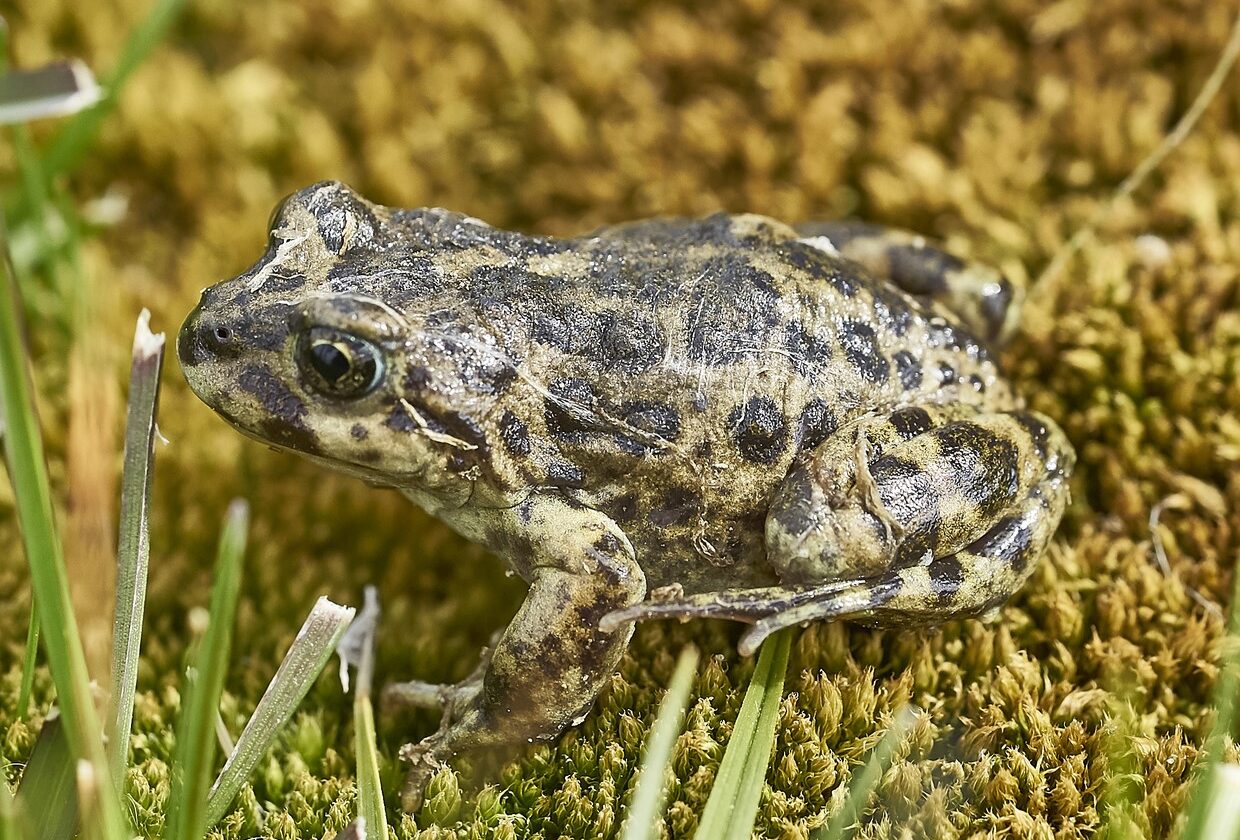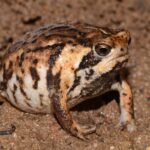- Atelognathus nitoi: Unveiling the Hidden World of Patagonia's Enigmatic Amphibian
- Exploring the Taxonomy of Atelognathus nitoi
- The Fragile Beauty of Patagonia: Natural Habitat and Range
- Portrait of an Adapted Survivor: Physical Characteristics
- Hidden Lives: Behavior and Life Cycle of Atelognathus nitoi
- Ecological Significance: A Vital Piece in Nature’s Web
- Under Threat: Conservation Challenges and Actions Needed
- A Cultural and Scientific Ambassador
- Conclusion: Preserving Patagonia’s Silent Guardian
Atelognathus nitoi: Unveiling the Hidden World of Patagonia’s Enigmatic Amphibian#
Amid the windswept beauty and chilly wetlands of Argentinian Patagonia dwells an amphibian whose quiet existence is as captivating as it is elusive: Atelognathus nitoi. Known colloquially as Nito’s frog, this species represents an intriguing blend of adaptability, resilience, and, sadly, vulnerability. Discovered relatively recently and named in homage to a dedicated naturalist, Atelognathus nitoi leads a life of subtle beauty and ecological importance that is often overshadowed by more familiar species. This amphibian’s story—quietly unfolding in a landscape of stunning natural contrasts—offers compelling insights into our world’s complex ecosystems, their fragility, and the critical role played by even the smallest denizens of nature.
What makes Atelognathus nitoi truly fascinating is its remarkable adaptation to a harsh, unpredictable environment—often braving conditions that lesser creatures would shy away from. Nestled within the cold marshes and peatlands near lagoons, this frog showcases both nature’s creativity and its delicate balance. Yet despite its hardiness, Atelognathus nitoi also stands as a symbol—its fate serving as a sensitive indicator of larger environmental shifts threatening Patagonia’s unique ecosystems.
Exploring the Taxonomy of Atelognathus nitoi#
Before diving deeper into the captivating life history and ecological context of Atelognathus nitoi, it’s essential to understand its classification. Scientifically categorized within the family Batrachylidae, this unique group boasts several endemic species primarily concentrated within temperate regions of South America. Under the genus Atelognathus, Nito’s frog shares close kinship with other specialists adapted to the specific environmental circumstances of Patagonia’s chilly plateau.
Its binomial name, Atelognathus nitoi, pays tribute to Argentinian herpetologist Nito Laffitte, whose tireless fieldwork and conservation efforts significantly advanced awareness and protection for amphibians in Argentina. Sometimes referred to by local naturalists as “Ranita de Nito,” this species offers not merely biological significance—but a heartening story of human dedication to biodiversity conservation.
The Fragile Beauty of Patagonia: Natural Habitat and Range#
In the rolling, starkly beautiful landscapes of central-western Patagonia, particularly around the province of Neuquén in Argentina, visitors who tread quietly near stagnant pools, marshlands, or lagoon edges might spot the discreet presence of Atelognathus nitoi. Their habitat exists within a patchwork of shallow freshwater lakes, bogs, and alpine steppe marshes—delicate ecosystems defined by tough grasses, mossy carpets, gentle reeds, and cold-temperature water bodies.
The frogs’ affinity for these water-rich yet demanding environments represents a sophisticated relationship forged over millennia. Patagonian wetlands are notably cool and boggy, often characterized by seasonally flooded basins and grassy edges—excellent habitats for respiratory exchange, hydration, and reproduction for these amphibians. The presence of organic-rich peat bogs and dense green vegetation allows Atelognathus nitoi to thrive in microhabitats sheltered from the region’s often harsh climatic variations.
The aquatic landscape they call home also houses numerous invertebrates, small arthropods, and plant life, forming the basis of a dynamic food web upon which these frogs depend. This balance is delicate indeed—minor climatic changes or human disturbances carry potential consequences to which species like Atelognathus nitoi remain acutely receptive.
Portrait of an Adapted Survivor: Physical Characteristics#
Atelognathus nitoi is beautifully adapted to its challenging home. Measuring modestly between 30 to 45 millimeters (just over an inch to about 1.7 inches) long, this diminutive amphibian possesses a rounded, compact body ideally designed to conserve heat and moisture. Its limbs—short yet surprisingly powerful—allow effective movement through dense marsh vegetation and shallow waters, capturing prey swiftly despite its small stature.
The frog’s coloration, combined with unique patterning of browns, greens, greys, and occasional rust-like flecks, provides excellent camouflage within the boggy wetlands and lush mosses of its habitat. This cryptic coloration guards against predators, making it near invisible in its environment. Texturally, its skin displays slight glandular roughness, a trait likely indispensable for retaining moisture in relatively arid conditions adjacent to cold water bodies.
A remarkable feature of Atelognathus nitoi is its partially webbed hind feet, finely shaped to navigate slippery substrates and swim gently through shallow lagoon water. Its eyes, positioned slightly upward, provide ample vision to observe insect prey or potential threats lurking above water or amid nearby plant stems.
Hidden Lives: Behavior and Life Cycle of Atelognathus nitoi#
Feeding Adaptations and Strategy#
Atelognathus nitoi survives by feeding primarily on small aquatic and terrestrial insects, including dipteran flies, beetles, and tiny arthropods abundant within its marshland domain. Its hunting strategy depends upon stealth and precision. Remaining still, camouflaged amongst submerged vegetation, the frog waits patiently for prey. As insects drift within range, the amphibian rapidly lunges forward with lightning reflexes, capturing prey swiftly with a sticky, agile tongue.
Reproductive Behavior and Parental Care#
Breeding behaviors for this subtly enchanting frog are intricately tied to environmental cues, notably temperature fluctuations and seasonal rainfall patterns. Typically, breeding occurs in shallow, temporary lagoon habitats formed during springtime snowmelt or heavy rains—conditions ideal for providing safety to developing eggs and larvae.
Male frogs produce soft, rhythmic calls, not robust or loud but clearly audible underwater to receptive females. After successful mating, females deposit gelatinous clusters of eggs amongst submerged vegetation or shallow, protected nooks. Unlike many amphibians, Atelognathus nitoi demonstrates minimal parental care once eggs are laid. Larvae—tadpoles well-suited to the cold water and abundant vegetation surroundings—develop gradually, completing metamorphosis over several months. This slow development underscores the importance of protected habitats remaining stable throughout their prolonged growth period.
Ecological Significance: A Vital Piece in Nature’s Web#
Although easily overlooked, the ecological contribution of species such as Atelognathus nitoi should never be underestimated. As adept predators of insects, these frogs help balance aquatic and terrestrial insect populations, impacting overall ecological stability. Likewise, they serve as prey for larger predators, including birds, reptiles, and mammals, thereby connecting disparate parts of the local food web. Their very presence is indicative of a healthy, balanced ecosystem within Patagonia’s distinctive wetlands.
Under Threat: Conservation Challenges and Actions Needed#
Today, Atelognathus nitoi remains classified as “Endangered” by the IUCN Red List. The challenges they face are severe: habitat loss due to drainage and land clearing for agriculture or urbanization, water pollution from pesticide runoff, climate change-induced alterations in precipitation patterns, and invasive species pressure. Notably sensitive to hydrological changes, even minor disruptions to their aquatic environments could spell disaster.
Urgent conservation measures have been initiated, including protected area designations, habitat restoration projects, and continuous monitoring by local scientists and conservation organizations. However, public awareness and sustained community involvement remain crucial for ensuring long-term survival. Advocating habitat protection, encouraging sustainable land practices, and fostering public understanding of species interconnectedness may collectively build a brighter future for this discreet yet fascinating amphibian.
A Cultural and Scientific Ambassador#
Though relatively obscure, Atelognathus nitoi nevertheless holds cultural importance among Patagonian communities, serving as an essential reminder of regional biodiversity and ecosystem integrity to indigenous peoples and local residents alike. Scientifically, these amphibians provide valuable indicators of environmental quality, climate health, and biodiversity richness, thus empowering future research and conservation initiatives.
Conclusion: Preserving Patagonia’s Silent Guardian#
Atelognathus nitoi teaches humankind an invaluable lesson about sensitive adaptation, intrigue, and ecological interconnection. Cherishing and safeguarding a delicate amphibian is not merely about saving one species—it’s about honoring and maintaining nature’s intricate, delicate balance. With greater conservation efforts, enhanced stewardship, and public engagement, this fascinating resident of Patagonia may yet continue to quietly weave its ecological web, enriching landscapes and lives alike for generations to come.








